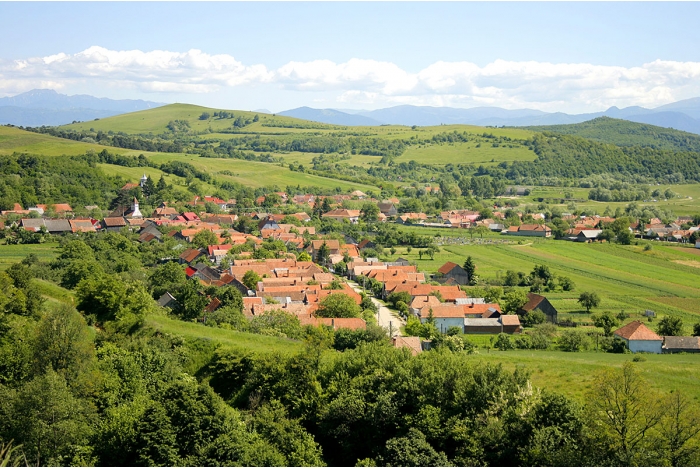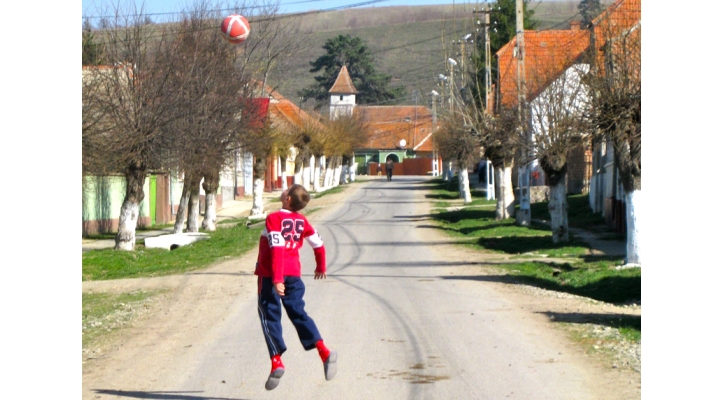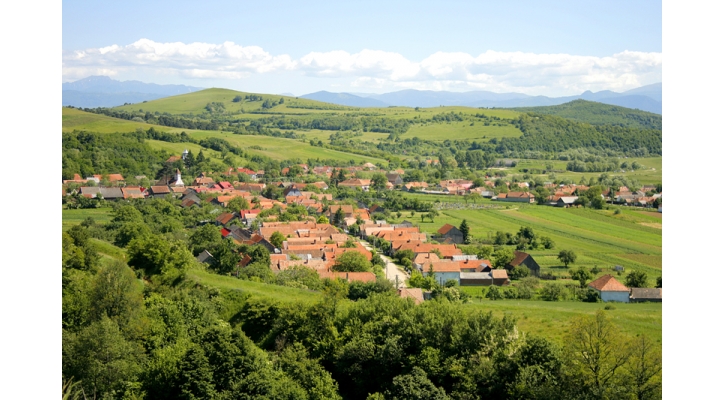Ariujd - Wake Up Slow
One Saturday morning, in early spring, I made a visit into a little village named Ariujd. Ariujd stretches its fingers and toes into the sun.

Ariujd seen from the nearby hills. Photo by Ana A. Negru
Scattered at the ends of it’s out stretched, hilly arms, the limbs of vast clustered trees reach like fingertips scrawling and curling upwards to the sky. Its body is a solidified patchwork of 14 the century cement homes, painted in vibrant colors of rusted gold and beachside ocean blue, lined with rooftops of crusted burnt orange.
It lay on a bed of open fields, with sheets that are twisted into knotted hills and valleys of pines, the distant mountain posts rest at the foot of its bed, and they masterfully cradle the horizon behind them.
Its head is in reality a little rustic child’s soccer field, with a face drawn of chalk and eyes of stones resting peacefully in their carefully chosen places.
The soccer field nestles a stream, where one can only imagine that on cloudy days, the tears of Ariujd spill over and are carried away.
A neck of golden dusted dirt and gravel road winds down from the field into the chest of the Village. The chest rests heavy with brick and stone, of homes and yards and towering walls and gates that breathe deeply and slowly.
Running parallel to the gravel neck, the throat, a single tiny stream that trickles down the center, saturating the sloping back yards and inner-village farmsteads, provides subtle nutrients throughout.
The hear tof Ariujd beats quielty, as it exists not in any tan gible or even descriptive form, but in the spirits of Ariud’s ancestors and history. It is ancient and wise, dating back to it’s founding year of 1468. And proudly home to the oldest house to ever be discovered in Romania, dating back to the remarkable year of 2500 BCE. More over, it boasts a significant archaeological history, being the revered location of one of Romania’s most renowned archaeological sites. The hills of Ariujd outline the site where numerous ancient pieces of pottery and stone have been uncovered, invaluable and timeless artifacts that today are preserved amongst Romania’s museums.
Another journalist and I were fortunate enough to make a short visit to the peaceful village early on a Saturday in April. We knew little of Ariujd, other than its great significant standing in Romania’s archaeology community. We did not expect to stumble upon the unique opportunity to meet and gain personal insight on Ariujd from the wisest resident of the village herself.
Sturdy, able, and more than endearing with a warm smile, Lucretia emerged from behind the great metal hinged gate surrounding her home to greet us and the founders of Satul-The village, whom we were accompanying. Lucretia is the oldest living resident of Ariujd. Our initial awe when presented with the vital woman’s age of 96, increased when proudly she futher informed us of her brother’s age of 91 and her sister’s of 93. Talk about substantial quality family genetics.
Shortly before Lucretia came out to greet us, in response to a general interest inquiry regarding the village, Ana Negru (creator of Satul) was fortunate enough to be welcomed inside Lucretia’s home. When Ana returned she was able to shed some personal light on Lucretia’s perspective of the village.
Lucretia had been happy to share some of her experiences with Ana. For example, she spoke of when she was young (in her twenty’s) when on the day of the Saint John Holiday the entire village would attend a local church service, which when commencing a fanfare from the Sanpetru Village would join them in progressing to the Olt River (which crosses near Ariujd) to assist with the religious ceremony of baptism, as lead by the local priest. She told Ana of how at one time, each family in the village had many animals, but now in a different time, only a few still remain with animal farms. As greatly as things have changed, Lucretia said she still pictures the village as it was when she was younger; with images of families with 40 horse drawn carts going out to work the field. She pictures the traditional costumes that were once worn every day (not only on important holidays) but daily to school. This is a disheartening change for Lucretia. As at that time, she said, the school was encouraging the preservation of tradition. As such, it was requested the children wear the costumes to school, and as well learn the traditional dances, sadly however, this is no longer seen today.
There is something to be said of preservation and vitality in Ariujd, two words that encompass the underlying fundamentals of tradition itself. From elderly passing us by on motorbikes and scooters to discovering siblings spanning nine decades, to historic homes (Lucretia’s home is from 1908 and appears to still be in good condition) and the revered archaeological site, it is obvious Ariujd is rich in ancestry.
by Sky-Lee Jarrett
Photos: Ana A. Negru & Sky Lee Jarrett






